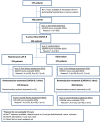Impact of different palliative systemic treatments on skeletal muscle mass in metastatic colorectal cancer patients
- PMID: 30144305
- PMCID: PMC6204584
- DOI: 10.1002/jcsm.12337
Impact of different palliative systemic treatments on skeletal muscle mass in metastatic colorectal cancer patients
Abstract
Background: Observational studies suggest that loss of skeletal muscle mass (SMM) is associated with chemotherapy-related toxicity, poor quality of life, and poor survival in metastatic colorectal cancer (mCRC) patients. Little is known about the evolution of SMM during palliative systemic therapy. We investigated changes in SMM during various consecutive palliative systemic treatment regimens using repeated abdominal computed tomography scans of mCRC patients who participated in the randomized phase 3 CAIRO3 study.
Methods: In the CAIRO3 study, mCRC patients with stable disease or better after 6 cycles of first-line treatment with capecitabine + oxaliplatin + bevacizumab (CAPOX-B) were randomized between maintenance treatment with capecitabine + bevacizumab (CAP-B) or observation. Upon first disease progression, in both groups, CAPOX-B or other treatment was reintroduced until the second disease progression, which was the primary study endpoint. We analysed 1355 computed tomography scans of 450 (81%) CAIRO3 patients (64 ± 9.0 years, CAP-B n = 223; observation n = 227) for SMM at four time points (i.e. prior to the start of pre-randomization initial treatment, at randomization, and at first and at second disease progression) using the Slice-o-matic software and single slice evaluation at the lumbar 3 level. By using accepted and widely used formulas, whole body SMM was calculated. A linear mixed effects model, adjusted for relevant confounders, was used to assess SMM changes for the total group and within and between study arms.
Results: During 6 cycles of initial treatment with CAPOX-B prior to randomization, SMM decreased significantly in all patients [CAP-B arm: -0.53 kg (95% CI -1.12; -0.07) and observation arm: -0.85 kg (-1.45; -0.25)]. After randomization, SMM recovered during CAP-B treatment by 1.32 kg (0.73; 1.90) and observation by 1.20 kg (0.63; 1.78) (median time from randomization to first disease progression 8.6 and 4.1 months for CAP-B arm and observation arm, respectively). After first progression and during reintroduction treatment with CAPOX-B or other treatment, SMM again decreased significantly and comparable in both arms, CAP-B: -2.71 kg (-3.37; -2.03), and observation: -2.01 kg (-2.64; -1.41) (median time from first progression until second progression CAP-B arm: 4.7 months and observation arm: 6.6 months).
Conclusions: This longitudinal study provides a unique insight in SMM changes in mCRC patients during palliative systemic treatment regimens, including observation. Our data show that muscle loss is reversible and may be influenced by the intensity of systemic regimens. Although studies have shown prognostic capacity for SMM, the effects of subsequent changes in SMM are unknown and may be clues for new future therapeutic interventions.
Keywords: Body composition; Chemotherapy; Metastatic colorectal cancer; Sarcopenia; Skeletal muscle.
© 2018 The Authors. Journal of Cachexia, Sarcopenia and Muscle published by John Wiley & Sons Ltd on behalf of the Society on Sarcopenia, Cachexia and Wasting Disorders.
Figures


References
-
- Online Document GLOBOCAN . Title of subordinate document In: World Health Organization International Agency for Research on Cancer. Accessed 5 Oct 2017.
-
- Dewys WD, Begg C, Lavin PT, Band PR, Bennett JM, Bertino JR, Cohen MH, Douglass HO Jr, Engstrom PF, Ezdinli EZ, Horton J, Johnson GJ, Moertel CG, Oken MM, Perlia C, Rosenbaum C, Silverstein MN, Skeel RT, Sponzo RW, Tormey DC. Prognostic effect of weight loss prior to chemotherapy in cancer patients. Am J Med 1980;69:491–497. - PubMed
-
- Barret M, Malka D, Aparicio T, Dalban C, Locher C, Sabate JM, Louafi S, Mansourbakht T, Bonnetain F, Attar A, Taieb J. Nutritional status affects treatment tolerability and survival in metastatic colorectal cancer patients: results of an AGEO prospective multicenter study. Oncology 2012;81:395–402. - PubMed
-
- Arends J, Bachmann P, Baracos V, Barthelemy N, Bertz H, Bozzetti F, Fearon K, Hütterer E, Isenring E, Kaasa S, Krznaric Z, Laird B, Larsson M, Laviano A, Mühlebach S, Muscaritoli M, Oldervoll L, Ravasco P, Solheim T, Strasser F, de van der Schueren M, Preiser JC. ESPEN guidelines on nutrition in cancer patients. Clin Nutr 2017;36:11–48. - PubMed
-
- Fearon K, Strasser F, Anker SD, Bosaeus I, Bruera E, Fainsinger RL, et al. Definition and classification of cancer cachexia: an international consensus. Lancet Oncol 2011;12:489–495. - PubMed
Publication types
MeSH terms
LinkOut - more resources
Full Text Sources
Other Literature Sources
Medical
Miscellaneous

